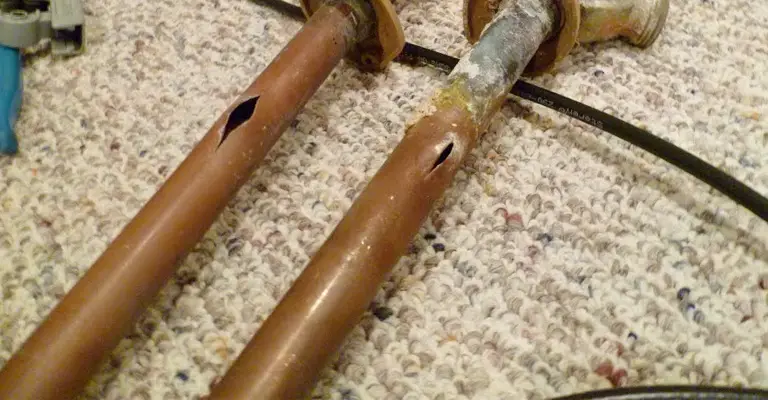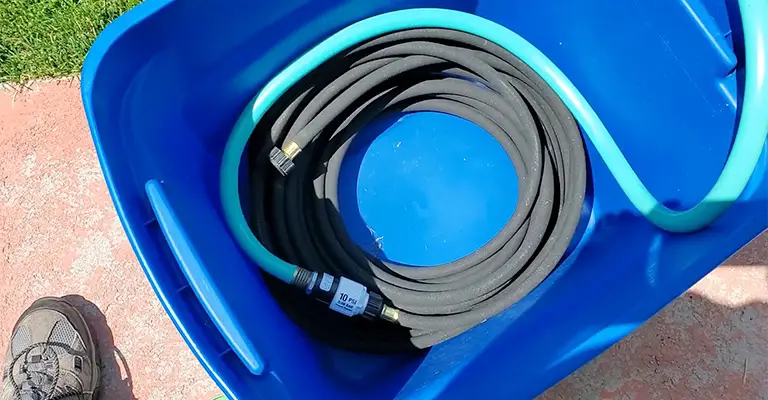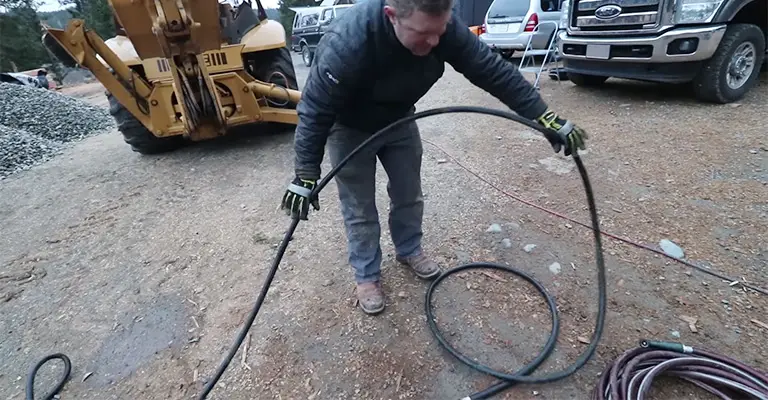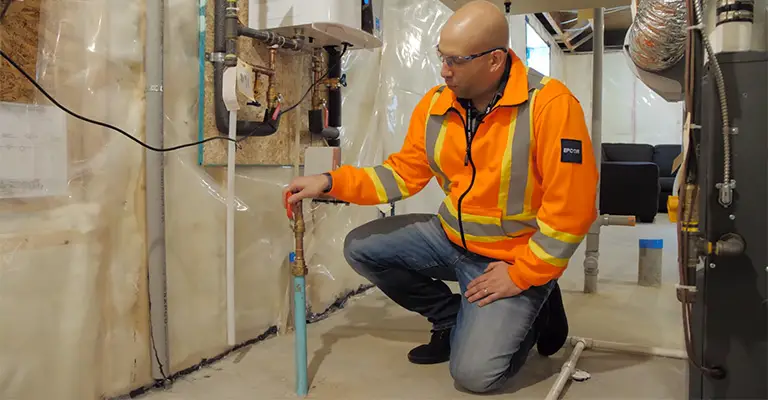You might be able to get away with just one night for $20-30, depending on your tiered pricing.
One summer, a soaker hose burst & I missed it for a week. I spent about $300 on that. It has been 5 years since then.
So, while leaving your water hose on for 24 hours may not cause significant damage to your wallet or the environment, it’s always best to be cautious and mindful of water usage.
In addition to the financial cost of leaving your hose on for an extended period of time, there are also environmental costs to consider.
According to the Environmental Protection Agency (EPA), outdoor water use accounts for almost 30% of household water use in the United States.
By leaving your water hose on for 24 hours, you’re wasting a significant amount of water that could be used for more critical purposes, such as drinking, cooking, and sanitation.
Furthermore, water is a precious resource that is becoming increasingly scarce in many parts of the world. By wasting water, you’re contributing to a global problem that affects everyone, not just you.
So, should you be worried if you leave your water hose on for 24 hours? The answer is yes, but not just because of the potential financial costs.
You should be worried because of the environmental impact of wasting water. To prevent this from happening in the future, consider installing a timer or automatic shut-off valve on your outdoor water source.
And make sure to permanently turn off your hose when you’re done using it. These simple steps can help you conserve water and protect the environment for future generations.
What Happens When You Leave A Hose On For A Long Period Of Time?

It is always hoped that your hosepipe will last long without splitting, kinking, or leaking when you use it to wash your car, garden, or mow your lawn. How does a hose work when you leave it on?
Most people forget to turn off the water after using a hose. With too many things going on at once, our minds can easily become distracted or overloaded.
Hoses that are left on for an extended period or under hot weather conditions are at high risk or low risk.
A hose left in water for a long time will grow stressed, causing a rupture, and leading to leaky faucets and broken valves.
In this way, a large amount of water will be wasted, increasing water bills. Damage will be caused to the surrounding ground, or it will become damp.
As a result of the pressure in the system, the valves leak water. This is because you have a rotating valve, whereas a 90-degree on-off valve (ball valve) would be better.
What Happens When You Leave A Hose On For A Week?

Maybe you went on vacation or visited a friend for a week or more and forgot to turn off the hose. There are three things that could happen: you might return to a wet lawn, a huge water bill, or both.
The damage caused by flooding will be severe if you leave your hose on for one week. The amount of water wasted will determine whether your garden or lawn becomes flooded. If it rained, your situation would be worse.
You may have an even worse problem if your neighbor’s yard is flooded, and he demands compensation. There are also times when you find water flowing into your basement, garage, or primary house.
Unexpected but expected expenses may arise during the water removal process. It is not uncommon for a person to break the bank for a week’s worth of water to be used.
So, how much water will come out if a garden hose emits about 10 gallons per minute? An average day will result in the release of about 14,400 gallons of fluid. In a week’s time, it should be around 100800 gallons.
If the average charge in your municipality is $15 per 1000 gallons, how much does it cost? In what range are you expecting the figure? That’s $1512 in total.
It is highly recommended that you purchase timers that will save you time from all these problems.
In case of an accidental turn-on of the hose, timers such as Holman or Aquatrip will automatically shut off the water (based on the preset time) and prevent the water from flowing.
By using a timer, you will not have to spend a large amount of money to pay your water bill, nor will you have to waste much more water.
What Happens When You Leave A Hose On For A Night?

It’s possible that you mistakenly left your hose running overnight after gardening. Sometimes, you may wake up to a flooded garden, driveway, basement, or water coming into your yard from your neighbor’s.
As a result of pressure on the hose, flooding occurs. Water flows at a greater rate in high-pressure situations than under low pressure.
Because of the high pressure, the hose is weak, causing it to burst and sometimes to disengage from the pipes. If you want your hose to last longer, turn it off for short periods when not in use to prevent cracking and bursts.
It is possible to use 1000 liters of water per hour by pressing the hose at high pressure. A 12-hour overnight period would have consumed 12000 liters of water.
Especially if the hose pipe is connected to a meter system, you will experience significant increases in your water bills.
At What Temperature Should You Turn Off The Outside Water?

Whenever the first wind of winter blows, it’s time to winterize your garden hose. Once the surrounding air reaches the freezing point, pipes are quickly frozen.
It is very dangerous for pipes to be frozen, as it can cause severe damage. The freezing point of water can be reached when it is cold outside, and water pipes that lack insulation tend to freeze and break.
Because of it, there is a risk of breaking valves, joints, and faucets. The cost of repairing is high as well. A water pipe releases its heat to the surrounding cold air when the outside air drops below 32 degrees Fahrenheit.
The result of this exchange of air is that the water in the pipes reduces and therefore freezes. Due to the formation of ice, pressure starts to build up. As a result of this pressure, the pipes burst.
When temperatures reach 32 degrees, faucets need to be turned on. Water draining from faucets should then be allowed to trickle down to prevent pipes from bursting.
Before doing anything else, you should turn off the water to prevent pipes from freezing. Find the outdoor faucet shut-off valve (it connects the outside faucets). Basements and utility rooms are usually the places where they can be found.
In the shut-off valve, water flow is geared. Using a rotating or ball valve to shut off the water flow is possible. To begin with, disconnect the exterior garden hose.
Your garden hose will not be needed during the winter; as a result, you should store it away until next season.
Make sure your garden hose is disconnected from the spigot. Taking this step will keep the hose from being damaged by ice.
Despite its molecular structure, ice requires more volume than liquid water. There will be damage to the hose due to expansion.
In the third step, drain your hose. Ensure that all water from the hose is drained. It is important to remember that even small amounts of water can lead to splits.
Afterward, wind it up on a reel and store it in a well-ventilated place. The life of the device will be prolonged this way.
Let some dripping happen from hot and cold faucets to alleviate any remaining water. As a result, pipes have some air space inside them and are less likely to be damaged by ice. Last but not least, open cabinet doors so the piping under sinks can be heated.
Don’t Forget To Disconnect Your Garden Hose
No matter if the outdoor faucet is frost-free, we still recommend that you remove the garden hose. Is there a reason we recommend removing the hoses from your outside faucets?
The garden hose can hold water if it is left attached. Ice on the hose will expand, damaging the connections to faucets, valves, and pipes.
If you are outside removing the hose, check the faucet visually. Is it leaking or dripping? In such a case, the faucet needs to be repaired before freezing temperatures begin to set in.
For spigots that cannot be used frost-free, we recommend closing the shut-off valve and draining them. We hope your pipes will survive the cold, frosty temperatures of the winter.
What Happens When You Leave Your Garden Hose Attached In Winter?
Whether the valves are closed or not, you should not leave your garden hose attached during winter, as this can cause internal water lines to freeze and burst. It is still not sufficient to have a ‘frost-free’ spigot.
The expansion of water when it freezes is similar, whether in an enclosed space or in an open space. A hose can become crowded during winter when water is left inside. It expands and freezes. As a result, taking up more space.
Unlike liquid water, ice water has less or no room to grow since its mass is heavier. Valve and joint failures result from the bursting of the pipes.
In winter, if you leave your garden hose connected to the water valve, you will notice that the walls next to the pipes are slowly eroding.
You will find that the foundation of your house will be perpetually wet, where the pipes are buried over time. Due to the expansion of water, the pipes will eventually rip apart.
A costly repair is required when pipes are ripped apart. When using the garden hose in winter, always disconnect it from the outside water valve. Check your faucet’s tightness as well.
In this way, interior water lines that freeze inside the house can be prevented from the burst. You should always drain the hose first, remove the sprayer nozzle, coil the hose into a reel, and store it.
It is important to remember that even a tiny amount of water left in a pipe by a spigot will cause the pipe system to crack or break. The outside pipe system needs to be winterized when the temperature drops.
You must shut off the faucets of the exterior faucets and detach the garden hose from the faucets. As a last precaution, do not use water from the exterior water pipe system.
Final Words
It is possible for flooding to occur in yards, basements, driveways, and lawns, as well as high water bills, damaged pipes, broken faucets, waste water, and compensation fees.
These can all contribute to flooding, which leads to the question, “What happens if you leave your hose running?”?’
If you leave your garden hose on for an extended period of time, you will do more harm than good. You will have to pay unexpected expenses and suffer flood damage.
If you are finished using a hose, permanently close the valve on the pipe to avoid unnecessary expenses and damage.
Don’t forget to drain the water left inside the hose after using it. Ensure its stored away from direct sunlight by looping it into a circle or rewinding it. It is pretty common for materials to crack and split due to exposure to sun rays.
Additionally, ensure you do not leave your hose connected to the faucet outside, as the pressure will increase, and the hose may burst. When the water pipes freeze during the winter, turn off the water from the main water valve.
By doing this, the pipes will not burst. Make sure that the hose you choose can withstand pressure from municipal supplies or wells and the temperatures throughout your home.






